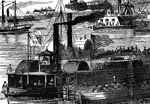Clipart tagged: ‘steamers’

Burning of Confederate gunboats
"Burning of the Confederate gunboats, rams, etc., at New Orleans and Algiers, on the approach of the…

Fort Hindman
"The investment of Fort Hindman, Arkansas Post, Ark., by the Federal troops under General McClernand,…
New Jersey Troops
"The New Jersey troops crossing the Chesapeake Bay, in sixteen propellers, on their way to Washington,…

Second Naval Battle
"Second naval battle in Hampton Roads- fight between the Federal ironclad Monitor, of two guns,…

Ship Island
"Ship Island, near the mouth of the Mississippi- United States war steamer "Mississippi" firing on a…

Burning of the White House
"Burning of the White House- the Federal troops, by command of General McClellan, abandoning their position…
Burning of the White House
"Burning of the White House- the Federal troops, by command of General McClellan, abandoning their position…



